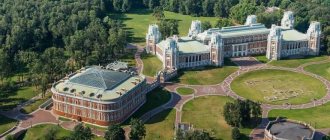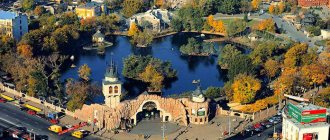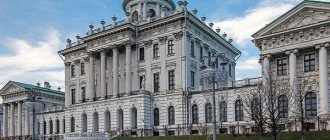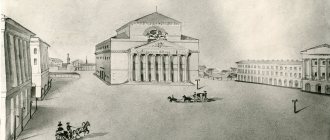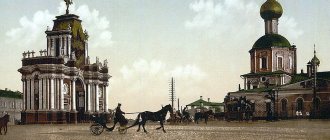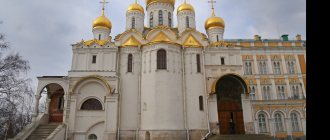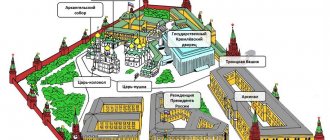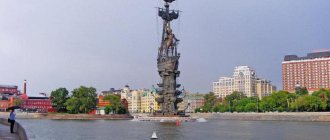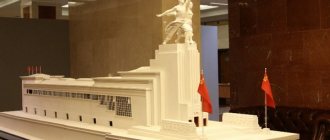Prince Dmitry Mikhailovich Golitsyn was a brilliant diplomat and an outstanding connoisseur of art. Suffice it to say that the collection of paintings that Empress Catherine acquired in Europe thanks to Golitsyn’s advice and efforts became the basis of the Hermitage.
His wife, née Ekaterina Cantemir, was particularly interested in medical and charitable affairs. For example, with interest from the capital bequeathed by her, every six years several graduates of the University went to Strasbourg, where there was the best teaching of midwifery at that time. The first famous Russian obstetricians were educated with her money.
In memory of his wife, the prince, shortly before his death, bequeathed the construction of a hospital - “an institution pleasing to God and useful to people.”
By the way, the first emergency medical aid point was organized at the hospital, which could be accessed around the clock.
Everything for the first time
Efrem Osipovich Mukhin, a professor at Moscow University and a surgeon, became the head doctor of the Golitsyn hospital . Here he performed the first successful neurosurgical operation in Russian history. In May 1803, a brick “weighing 12 pounds” fell on Prince Shakhovsky’s serf plasterer Trofimov on his head. This operation is described by Mukhin as “an observation of a break in the top of the head, connected to a wound in the brain and its covering” with 12 drawings attached. This was the first clinical analysis in the history of Russian medicine.
In the first four years, 688 operations were performed at the Golitsyn hospital: surgical, obstetrical and gynecological, eye and ear. More than 10 thousand people were vaccinated with smallpox. Mukhin opened the first traumatology department in Russia here, introduced steam and mineral baths, massage, and electrotherapy into medical practice. The first emergency medical care point was organized at the hospital, which could be accessed around the clock. A year after the opening, in 1803, the chief doctor also abolished the payment for treatment.
Dmitry Mikhailovich Golitsyn. Photo: Public Domain
short biography
1897 – graduated from the Ilyinsky elementary public school. 1898-1902 – Studied at the paramedic school at the Golitsyn Hospital in Moscow. 1904-1909 - as a person liable for military service, he served as a paramedic in the Moscow convoy team. 1905 – submitted documents to Moscow University for the Faculty of Medicine. 1914 - (beginning of the 1st World War) - mobilized and enlisted in the lists of the 11th Phanagorian Grenadier Regiment, in a non-combatant dressing detachment. 1914-1917 – as part of the regiment, he participated in campaigns against Austria and Germany, in particular in the “Brusilovsky breakthrough” in June 1916 – against the Austro-Hungarian troops. 1921 – medical assistant at the Higher Electrotechnical School of the Command Staff of the Red Army in Sergiev Posad. 1925 – graduated from the medical faculty of the 2nd Moscow University, which he entered after the end of the Civil War. After graduating and receiving the title of doctor, Alexey Vikentievich worked in various medical institutions in Moscow and the region. 1944-1946 – sent to work in the Mongolian Republic. After 1946, he worked in various clinics in Moscow and the region, the MONIKI clinic, the sanatorium of the Ministry of Defense, and the Kremlin clinic.
Rubens and the men's department
The hospital was in charge of a greenhouse, a park (now this is a large part of Gorky Park, reaching the river), ponds and even an art gallery, where 477 paintings by famous foreign masters were exhibited - the Viennese collection of Dmitry Mikhailovich Golitsyn , which he collected all his life. It was the first free and public gallery in Moscow. Only “peasants and those in bast shoes who did not understand art at all” were not allowed into it.
Later, the collection was sold at twenty-eight auctions, and Empress Maria Feodorovna . With this money, the men's department of the hospital was built.
Article on the topic
For children of all classes. History of Morozov Hospital
Grebnevsky cache and abandoned Golitsyn hospital
The Grebnevo estate, which we already wrote about once, can rightfully be called one of the most noticeable in the entire Moscow region. Among other noble nests, it stands out for its unprecedented scale, which is reflected here in literally everything: size, architectural forms, interiors, landscape ensemble and even personalities. Unfortunately, now all that remains of this once magnificent estate are ruins that are practically beyond restoration, which, however, can tell many interesting stories.
The Grebnevo estate was mentioned back in the 16th century, but its greatest prosperity occurred in the period from 1781 to 1823, when the estate was owned first by General Ilya Gavrilovich Bibikov, and then by Prince Sergei Mikhailovich Golitsyn, a “pillar” of Moscow society, nicknamed “the last Moscow nobleman.”
Panorama of the Grebnevo estate. Artist: M.S. Baev (1902-1979)
Being very influential and rich people of their time, both of these people paid great attention to their country house, decorating it in every possible way, adding outbuildings, laying out huge parks, digging ponds, contracting the best gardeners from abroad, hiring famous architects and not sparing a single thing. money, no time. The results of the work done impressed the secular society, which often gathered in Grebnevo, and still impress descendants. The name of Sergei Mikhailovich Golitsyn is also associated with the more famous Kuzminki estate today, whose owner and organizer he was also, and which has been completely restored since 1997.
During the improvement of the Grebnevo estate, S.M. Golitsyn paid attention not only to its decoration, but also to quite practical things. In the early 1830s, he rebuilt several residential buildings located a kilometer east of the main manor house, opening a hospital in them. This was done on a scale characteristic of the prince - the famous architect M.D. was invited especially for this project. Bykovsky, under whose leadership the main hospital building was erected, as well as two outbuildings connected to the main building by passages, several more auxiliary buildings and a stone fence. The entire complex subsequently became known as the hospital ensemble of the Grebnevo estate, representing no less a work of art of architects than the estate.
Local historians, studying the history of Grebnevo, unearthed one interesting story that happened on the estate shortly before the construction of the hospital. The story is similar to a legend in some places, and researchers have different opinions on it, but that doesn’t make it any less interesting. According to a study by local historians, on August 25, 1812, when Napoleon approached Moscow, mysterious boxes sealed with wax were brought to the estate under the cover of darkness on several carriages. They were brought by Alexander Dubrovin, the caretaker of another, more famous, Golitsyn hospital in Moscow.
Here it is worth making a small digression and saying that this famous hospital, which still stands on Leninsky Prospekt and functions perfectly, was built at the turn of the 18th-19th centuries by Alexander Mikhailovich Golitsyn, and the funds for its construction were bequeathed before his death by another representative of the Golitsyn family - Prince Dmitry Mikhailovich Golitsyn (1721-1793). The hospital was originally conceived “for the poor” and it actually accepted patients of all classes.
View of the Golitsyn Hospital in Moscow. Engraving from 1798
Alexander Mikhailovich Golitsyn (1723-1807), being the Russian ambassador to Great Britain, an actual privy councilor, senator and chief chamberlain, had a great passion for collecting paintings. His personal collection, further expanded after the death of his cousin, who also collected paintings and bequeathed his entire collection to him, numbered about five hundred paintings. The collection included paintings by P. Rubens, A. Van Dyck, Jan Brueghel the Elder, Rembrandt, Raphael, Titian, Caravaggio, Vecchio, Poussin and many others. A.M. Golitsyn believed that such a collection would be useful to the fatherland, and therefore built a two-story pavilion next to the Moscow Golitsyn Hospital, in which he placed his paintings, bequeathing them to the hospital for eternal storage. In 1810, after the death of A.M. Golitsyn, the first Moscow public art gallery of Western European art opened in this pavilion, and the hospital itself, since 1807, was headed by another representative of the Golitsyn family - Sergei Mikhailovich Golitsyn, already known to us.
Now let's go back to the tragic year 1812 and that August night, when in the Grebnevo estate near Moscow, which, as you remember, belonged to Sergei Mikhailovich Golitsyn, carriages with mysterious boxes suddenly appeared - now we can easily guess their contents!
The prince, feeling that the war is taking a very dangerous turn and the enemy is already at the gates of the capital, orders to secretly remove all the paintings from the gallery at the Golitsyn hospital to his estate near Moscow, and there they should be properly hidden so that the most valuable collection of paintings does not go to the French. His order was successfully executed by Alexander Dubrovin, whom we have already mentioned above. Under cover of darkness, accompanied by one soldier - Ivan Lazarev - he delivered the paintings to Grebnevo. However, the prince was not so frivolous as to hide the collection in a rich estate, which would certainly be of interest to the French, and therefore ordered a hiding place to be built a kilometer east of the main estate house - in residential buildings and in the barnyard, where a few years later the Golitsyn hospital ensemble would be built Grebnevo estate.
The estate manager wrote the following note to the prince that night:
“Most illustrious prince! Most Gracious Sovereign!
By order of your Excellency on August 25th, the paintings sent in boxes sealed with matting and oilcloth, with seals attached to them, were safely delivered here by soldier Ivan Lazarev, which with due care were placed in the barnyard in the cellar with fakes in half of it under the boxes. scaffolding, and with the laying of two windows and doors by two masons sent for this, who were then released. - Of the 75 rubles received from your Excellency, how much was used in payment for the delivery of paintings to cab drivers and masons when they were here, with a provision of 2 rubles. 50 per day, as much as they owed, I will deliver to you, sir, an account, at which time the rest will be returned to them.
PS At the end of this, at the command of your Excellency received on August 28, I most dutifully inform you that upon the arrival here of the Golitsyn hospital caretaker Mr. Dubrovin, the sent paintings were placed at the barnyard in the cellar, which was found for them in a way: then they remain in it without any dismantling of them, with a guard assigned to them for the night"
Fragment of a map of Moscow surroundings in 1852
The boxes with the paintings were hidden in the basement of a nondescript stone house in which livestock workers lived. The doors to the basement and several windows were covered with brickwork and then carefully plastered. Few people knew about the entire operation, and even less about the contents of the boxes.
Prince S.M.'s plan Golitsyn's project to preserve the greatest collection of paintings was crowned with success. Everyone knows what the French did to Moscow, but the building of the Golitsyn hospital was more fortunate - Napoleon used it for its intended purpose, placing the wounded in it. The French never got the paintings.
However, four years later, on November 28, 1816, Sergei Mikhailovich Golitsyn was given imperial permission to sell the entire collection of paintings of the Golitsyn Gallery. The prince was forced to make this decision due to the difficult financial situation in which the hospital found itself. Between 1816 and 1818, 28 auctions were held and 324 paintings and marble statues were sold for a total of 238,645 rubles. There were still many paintings left, which it was decided to sell with a concession of half their auction value, for which permission was obtained from Empress Maria Feodorovna, who herself took part in the lottery that concluded the auction.
Now most of the paintings of the Golitsyn Gallery are located in Russia, the most valuable ones are in the Hermitage, several are in museums in the countries of the former USSR, and one, Pietro Perugino’s triptych “The Crucifixion with Those Present,” is in the Washington National Gallery. However, this painting was sold to the Americans only in 1931.
As for the Grebnevo estate, in Soviet times it was first plundered, then a sanatorium for tuberculosis patients was located within its walls, then the Shchelkovo Technical School of Electrovacuum Devices, and later the NPO Platan. In 1960, it was nevertheless recognized as an architectural monument and they even tried to restore it, but the appearance of the estate had already undergone too many changes. A fire in 1991 completely destroyed the estate.
The Golitsyn hospital of the Grebnevo estate, on the site of which a cache with paintings by great painters was once located, also fell into disrepair over time, and now only ruins overgrown with forest remain.
Coordinates of the abandoned Golitsyn hospital in the Grebnevo estate: 55 °56'56″N 38 °5'41″E
Beneficial place
Alexander I was personally present at the consecration of the hospital church , calling the Golitsyn hospital “the best monument to such a useful use of capital.”
This church became a refuge for Dmitry Mikhailovich himself. His ashes were transported from Vienna, where the prince was very loved (a street and even a mountain were named after him), and buried in the crypt of the temple.
In 1814, the poet Derzhavin, having served in the hospital church, bowed to the marble bust of the hospital’s founder with the words: “Such benefactors must be honored and worshiped in marble.” Then Derzhavin walked in the garden, admiring the wonderful view of the Moscow River, and even invited his companion Vasily Lvovich Pushkin to write something about this “beneficent place.”
The Golitsyn hospital was the first medical institution in this “beneficent place”, which was later almost completely built up with medical institutions. Now this is the historical Golitsyn building as part of the city clinical hospital No. 1 named after N. I. Pirogov, located at 8 Leninsky Prospekt.
Photo: RIA Novosti/Ilya Pitalev
Youth. Paramedic school. Imperial University
Born and lived in the village of Ilinskoye, Aleksandrovsky district, Vladimir province. My father worked for the merchant Dobrovolsky Georgy Gordeevich at the Ilyinsky Crystal. In 1897, Alexey graduated from the Ilyinsky Primary Public School. From 1898 to 1902 he lived and studied at the paramedic school at the Golitsyn Hospital in Moscow. His aunt Dmitrieva Anisya Egorovna worked on the board of the hospital. Thanks to her care, all of Alexei’s brothers and sisters graduated from this school. From 1904 to 1909, as a person liable for military service, he served as a paramedic in the Moscow convoy team. In 1905, he applied to Moscow University to study at the Faculty of Medicine.
With the outbreak of the 1st World War in 1914, he was mobilized and enlisted in the lists of the 11th Phanagorian Grenadier Regiment, in a non-combatant dressing detachment. As part of the regiment, he participated in campaigns against Austria and Germany in 1914-1917. In particular, in the “Brusilovsky breakthrough” in June 1916 against the Austro-Hungarian troops.
Coffins - for the needs of the state
At one time, the hospital management had a utopian idea that a working person could spend his entire life within the walls of a medical institution and under its care - from birth to old age, living out his life in a hospital almshouse, and during his lifetime having a guaranteed job as a paramedic or servant. For the sake of this idea, a maternity hospital was even opened for hospital servants in labor in 1868.
By an evil irony of fate, it was these representatives of the hospital staff who in 1918 destroyed the graves of the Golitsyns in the temple crypt and donated their copper coffins to the needs of the proletarian state. The prince’s ashes were reburied in the hospital courtyard, but where is unknown.
From the book “100 years of the Golitsin Hospital”
CERTIFICATE
Paramedic school at the Golitsyn Hospital for the pupils of the IMPERIAL Orphanage. This was given to the son of a tradesman Alexey GROMAKOV, born. February 11, 1884, that he, being from 1998 to 1902 at the Paramedic School, with excellent behavior, studied:
Law of God, Russian language, Arithmetic, Calligraphy, Latin language, Geography, Russian history, Geomertia, Zoology, Botany, Anatomy and Physiology, Operative surgery, The doctrine of fractures and dislocations, Desmurgy, Pathology and therapy, Hygiene, Pharma Cognosis, Pharmacology, Pharmacy , Prescription, Pathological surgery, Pharmaceutical chemistry, Providing assistance to suddenly ill people, Episostia, Syphytology, with practical classes at the Golitsyn hospital and its pharmacy with excellent success.
Now, according to what was done at the School, in the presence of G.G. deputies of the IMPERIAL Moscow University, the Moscow Medical Administration and the IMPERIAL Moscow Orphanage, testing in all of the above subjects, approved by the senior paramedic with the rights granted by law to this rank.
After serving military service, he enjoys the rights of the 3rd category.
Given 1902 May 20 days. No. 67. Chief Director of the Golitsyn Hospital and Manager of the Paramedic School Prince Sergiy Golitsyn
School Class Inspector Sergei. Deryuzhinskiy Senior warden Spasskiy With genuine correct Acting. clerk Stanislav Zhivult
